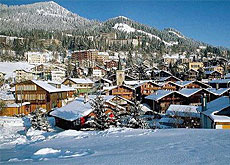
Learning multiculturalism in Leysin

The French-speaking village of Leysin is every bit as international as Geneva, even if it cannot compete on size.
The foreign students attending the four international schools in Leysin lend the alpine resort a multicultural character second in Switzerland only to Geneva.
Japanese student Naoyuki Ito is one of about 800 students who flock each year to the boarding schools of Leysin. They account for about 25 per cent of the population.
For many, it’s their first taste of life in a foreign country and can be an eye-opener.
“Before I came here, I didn’t know Switzerland had any big cities,” says Ito. “I thought it was mostly wilderness.”
Tuberculosis to teaching
Where once tuberculosis patients roamed the corridors, students from more than 60 nations head for classes in the turn-of-the-century buildings constructed originally as health clinics.
The dry mountain air and sun-exposed slopes of Leysin began attracting thousands of tuberculosis sufferers to the village in the 19th century.
That spawned a burgeoning health industry, which lasted until the end of the Second World War.
The clinics did not lie dormant long. About a decade after the last patient left, the first clinic to be converted into an international school opened its doors. It was soon to be followed by others.
The students are drawn to Leysin – like the tuberculosis sufferers before them – by the alpine environment.
Safety first
But it is the Swiss village’s reputation as being a safe place that is more important to the students and their parents than the pure air or scenery.
“We rate the safe society of Switzerland very highly,” says Hiroshi Watanabe, principal of the KLAS Japanese high school.
KLAS offers its Japanese teenagers a dual curriculum: one preparing students for Western universities and the other for Japanese centres of higher education.
“We also want to utilise Switzerland’s unique geographical, political and socio- cultural setting,” he adds.
“We can travel freely and easily around Europe [from Leysin]. This kind of setting enables us to educate Japanese students as international citizens.”
“It’s the location, the beauty of the Alps, the peacefulness and the safety of Switzerland,” echoes Doris Ott, co-director of the Leysin American school.
Ott boasts that Antarctica is the only continent not represented by the high school’s student body.
“We have children of diplomats, of expatriate families and international business families who wish their children to have a truly international perspective and education,” she continues.
Not Swiss
International but not necessarily Swiss. Apart from a few cultural excursions around Switzerland, the students, regardless whether they attend the Japanese or American school, have little direct contact with Swiss culture or the Swiss.
The teachers at both schools come from far and wide – but not one is Swiss. At the Japanese school the staff is made up of a mixture of native English-speakers and Japanese teachers.
“Swiss culture or Switzerland is in the background almost,” says Sim Huang, a science teacher at the American school.
“Switzerland is safe and things work and are on time. It’s almost taken for granted,” he adds.
Interactive teaching
Most of the teachers employed at the American school are brought in for their American interactive teaching technique, as Ott describes it.
Otherwise, she says, the school is more international than American, offering students the International Baccalaureate.
Switzerland is not the first foreign country that many students at the American school have lived in, and it probably will not be the last.
One young student says she spent much of her life sailing around the world on her father’s sailing boat, before choosing to go to boarding school in Leysin.
Ski and snowboard
Another says she chose the American school because she valued Switzerland’s multiculturalism, and the fact that she can ski and snowboard in Leysin.
Ott says many do not know what living in Switzerland means to them until they move away and have time to reflect.
As far as most of the Japanese students are concerned, it is the first time they are in a foreign, European environment.
And it really does not matter whether the culture is English, French or German – the most important thing is that they are living abroad and learning English.
swissinfo, Dale Bechtel
Foreign students account for about 25 per cent of Leysin’s population, making the international schools the most important economic force in the village.
Leysin’s reputation as an international centre dates back to the late 19th century when it developed into a leading health resort. Tuberculosis sufferers were drawn by the dry mountain air.
Some of the schools are housed in the buildings, which were originally constructed as clinics at the beginning of the 20th century.
Leysin has four international schools:
Leysin American School
American College of Switzerland
KLAS Japanese high school
Glion Hotel School

In compliance with the JTI standards
More: SWI swissinfo.ch certified by the Journalism Trust Initiative




























You can find an overview of ongoing debates with our journalists here . Please join us!
If you want to start a conversation about a topic raised in this article or want to report factual errors, email us at english@swissinfo.ch.